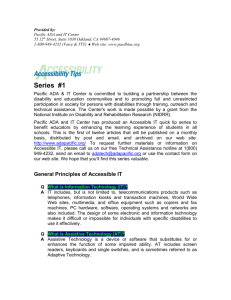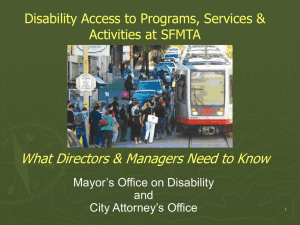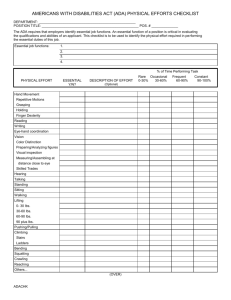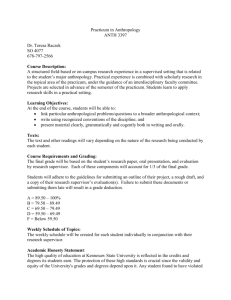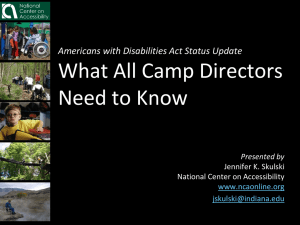Web Accessibility and the ADA 1-10
advertisement
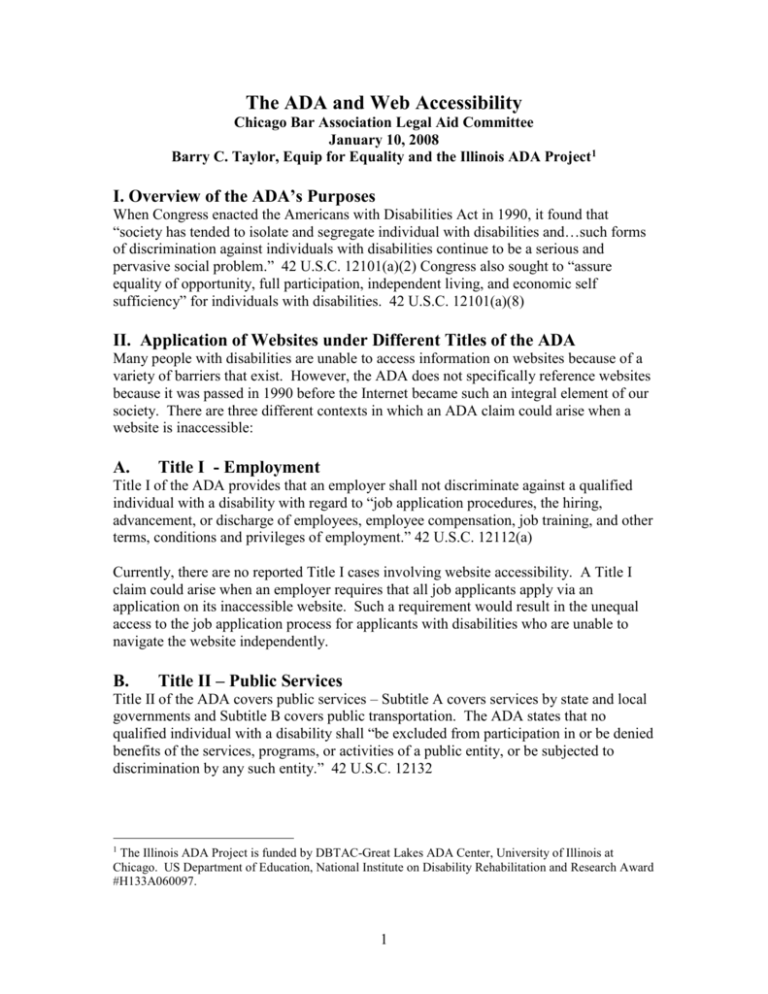
The ADA and Web Accessibility Chicago Bar Association Legal Aid Committee January 10, 2008 Barry C. Taylor, Equip for Equality and the Illinois ADA Project1 I. Overview of the ADA’s Purposes When Congress enacted the Americans with Disabilities Act in 1990, it found that “society has tended to isolate and segregate individual with disabilities and…such forms of discrimination against individuals with disabilities continue to be a serious and pervasive social problem.” 42 U.S.C. 12101(a)(2) Congress also sought to “assure equality of opportunity, full participation, independent living, and economic self sufficiency” for individuals with disabilities. 42 U.S.C. 12101(a)(8) II. Application of Websites under Different Titles of the ADA Many people with disabilities are unable to access information on websites because of a variety of barriers that exist. However, the ADA does not specifically reference websites because it was passed in 1990 before the Internet became such an integral element of our society. There are three different contexts in which an ADA claim could arise when a website is inaccessible: A. Title I - Employment Title I of the ADA provides that an employer shall not discriminate against a qualified individual with a disability with regard to “job application procedures, the hiring, advancement, or discharge of employees, employee compensation, job training, and other terms, conditions and privileges of employment.” 42 U.S.C. 12112(a) Currently, there are no reported Title I cases involving website accessibility. A Title I claim could arise when an employer requires that all job applicants apply via an application on its inaccessible website. Such a requirement would result in the unequal access to the job application process for applicants with disabilities who are unable to navigate the website independently. B. Title II – Public Services Title II of the ADA covers public services – Subtitle A covers services by state and local governments and Subtitle B covers public transportation. The ADA states that no qualified individual with a disability shall “be excluded from participation in or be denied benefits of the services, programs, or activities of a public entity, or be subjected to discrimination by any such entity.” 42 U.S.C. 12132 1 The Illinois ADA Project is funded by DBTAC-Great Lakes ADA Center, University of Illinois at Chicago. US Department of Education, National Institute on Disability Rehabilitation and Research Award #H133A060097. 1 In Martin v. Metropolitan Atlanta Rapid Transit Authority, 225 F. Supp. 2d 1362 (N.D. Ga. 2002), a group of people with disabilities brought suit under Title II of the ADA against the Atlanta public transportation system. The suit cited numerous ADA violations, including MARTA’s inaccessible website. The court found that the failure of MARTA to provide the blind community with equal access to its website violated Title II of the ADA. The court held that until MARTA made its website accessible, it was violating the ADA’s mandate of “making adequate communications capacity available, through accessible formats and technology, to enable users to obtain information and schedule service.” C. Title III – Public Accommodations and Services Operated by Private Entities Title III of the ADA covers public accommodations (i.e. private businesses open to the public). Under Title III, people with disabilities may not be discriminated in the “full and equal enjoyment of the goods, services, facilities, privileges, advantages or accommodations of any place of public accommodation.” 42 U.S.C. 12182(a) 1. Place of Public Accommodation A major issue in Title III litigation is whether the defendant is actually a “place” of public accommodation. The Circuits are split as to whether there has to be a physical space in order to be covered by Title III. In a case involving insurance discrimination, the Seventh Circuit Court of Appeals held that Title III did not require a physical space for liability. See Doe v. Mutual of Omaha, 179 F.3d 557 (7th Cir. 1999) Interestingly, although Doe did not involve website accessibility, the Seventh Circuit explicitly listed websites among the entities that are covered by Title III. Id. at 559 2. Web Accessibility Cases In Access Now v. Southwest Airlines, 227 F. Supp. 2d 1312 (S.D. Fla. 2002), a disability advocacy organization and a blind individual sued Southwest Airlines because its website was inaccessible. The court dismissed the claim that an airline’s website violated Title III of the ADA. Specifically, the court found that because the website does not exist in any particular geographical location, it was not a place of public accommodation. The case was appealed to the Eleventh Circuit Court of Appeals. However, on appeal, the plaintiffs changed their argument claiming that the website was part of a “travel service” and therefore, covered by Title III of the ADA. The 11th Circuit dismissed the case because this argument had not been made before the trial court and was inappropriately first raised on appeal. Access Now v. Southwest Airlines, 385 F.3d 1324 (11th Cir. 2004) In National Federation of the Blind v. Target Corporation, an advocacy group for blind people claimed Target violated Title III of the ADA and California state laws because its website was inaccessible. In denying Target’s Motion to Dismiss, the judge concluded that to the extent that plaintiffs alleged that the inaccessibility of www.target.com impeded the full and equal enjoyment of goods and services offered in Target stores, the plaintiffs stated an ADA claim. In other words, the court found the plaintiffs’ ADA claim viable because Target’s website had a “nexus” to Target stores, which are places of 2 public accommodation. The court also found that Target treats its website as an extension of its stores and as part of Target’s overall integrated merchandising efforts. [2006 WL 2578282 (N.D. Cal. Sept. 6, 2006)] More recently, the court issued another order certifying the case as a class action. The class is defined as “all legally blind individuals in the United States who have attempted to access www.target.com and as a result have been denied access to the enjoyment of goods and services offered in Target stores.” (There is also a “subclass” for California residents for claims arising under California law.) The court granted Target’s motion for summary judgment with respect to an individually named plaintiff, but allowed for the substitution of other named plaintiffs who can establish that their difficulties with Target’s website have impeded access to the goods and services available in the store. The court held that the named plaintiff’s state law claims survived Target’s motion for summary judgment. [2007 WL 2846462 (N.D. Cal. Oct. 2, 2007)] In May 2005, LaSalle Bank worked with Equip for Equality and others to update its websites to make them more accessible. For a copy of the agreement, go to: http://equipforequality.org/programs/assistivetechnology/lasallebank_settlement.doc In June 2007, Radio Shack agreed to change its website to make it accessible to people who are blind and visually impaired. For information on the agreement, go to: http://www.radioshackcorporation.com/ir/release_details_main.php?id=918 III. ABA Resolution on Accessibility of Websites In August 2007, the American Bar Association passed a Resolution urging that websites operated by individuals and organizations associated with the legal profession be “created and maintained in an accessible manner which is compatible with reasonable technologies (known as assistive technology) that permit individuals with visual, hearing, manual, and other disabilities to gain meaningful access to these websites.” The ABA affirmed the importance of making legal information and services accessible to people with disabilities. The ABA found that there is “a direct link between the accessibility of legal websites and the ability of people with disabilities to find employment with legal employers, work as lawyers and paralegals, access legal information and services, and obtain competent legal representation.” The ABA’s Resolution also includes practical advice on making websites accessible. IV. Conclusion The case law is still developing as to whether there is a cause of action under the ADA for inaccessible websites. However, employers, public entities and private businesses should make their websites accessible to achieve the underlying purpose of the ADA to promote the full participation of people with disabilities in our society. 3




